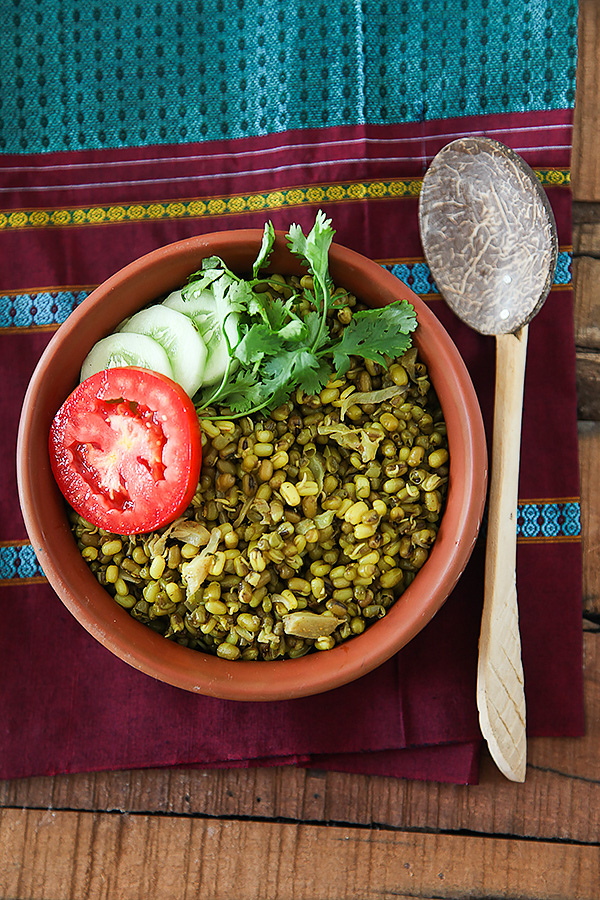
A few years ago, an ayurvedic doctor told me to incorporate mung beans in my diet everyday. It is full of B vitamins and will give you a lot of energy he said. Although I have eaten mung beans since childhood, my mother's mung bean curry with rice being my all time favourite food, I started to eat mung beans a lot more since then.
Mung beans are highly revered in Ayurveda. They are not just easy to digest but are rich in protein, fiber, vitamins, minerals, antioxidants and phytonutrients. Mung beans have been a part of the traditional Indian diet for thousands of years and many regional recipes make their appearance in the culinary landscape of the subcontinent.
Hesar Kaal Palya, is a side dish eaten with whole wheat roti and bhakri (millet pancakes) made with sorghum or pearl millet in North Karnataka.
If you peek into the daily food cooked at homes in these regions, you will often find a kaal (lentil) palya along with other vegetable dishes. Right from office goers, school and college students to farmers working on the field relish these lentils as a part of an everyday meal. Kaal palya is also relished with curd (yogurt) rice, another staple dish for the people of this region.
Mung beans are one of the best sources of plant protein available to us and now that I see it being included in commercial protein powders and the like, my belief in the traditional Indian diet is further strengthened.
And ofcourse thanks to the good old doc for bringing back this much loved dal into my diet.
Karnataka Style Sprouted Whole Mung and Cabbage Vegetable | Hesar Kaal Palya
You can use any lentils instead of mung dal as well.
Ingredients:
220 gm (1 cup) whole mung dal
175 to 250 ml (3/4 to 1 cup) water*
2 tbsp oil
½ tsp mustard seeds
½ tsp asafetida powder
1 or 2 green chilies (pounded into a paste in a mortar and pestle or chopped)
a sprig of curry leaves
½ tsp turmeric powder
1 cup cabbage, chopped
1 tsp cumin seed powder
1 ½ tsp salt
juice of a lime
Method:
Wash the mung dal in plenty of water and place them in a bowl or any other utensil of your choice. Pour water over the dal, cover and keep overnight or for 8 to 10 hours. If you want to sprout the beans, drain the water and cover it with a plate. After 8 to 10 hours, the beans will sprout.
In a wok, heat the oil on medium flame and once the oil is hot, add the mustard seeds. After the mustard seeds start to pop lower the heat, add the asafetida powder, green chili paste, stir briefly and then add the curry leaves. After the curry leaves sizzle put in the turmeric and cabbage if using, stir and cook covered until the cabbage is done. Add the cumin seed powder, mung beans and 3/4th cup water.
Put in the salt and cook until the mung beans have absorbed all the flavours and are dry. If required use more water to cook the beans.
Squeeze in the lime juice, mix nicely and serve with any Indian breads or rice of your choice. You can also eat this like a salad.
*The amount of water used depends on the quality of the beans.
Serves 4

I love your recipes.Reason behind this is you are
Vegetarian.That's why i like your all cooking.
I am also a vegetarian person.
YOU ARE MAKING *SAATVIC BHOJAN* ALIVE
All the best take care bye bye……
dear anushruti,
thank you for this lovely, healthful recipe. just one doubt: in the line 'Add the cumin seed powder, cooked mung beans and 3/4th cup water' surely you don't really mean cooked mung beans? the mung beans have only been sprouted at this point, right?
warm regards and many thanks for your terrific recipes,
anjali
The mung bean is raw. The recipe has been updated! Thank you. 🙂
Thank you. 🙂